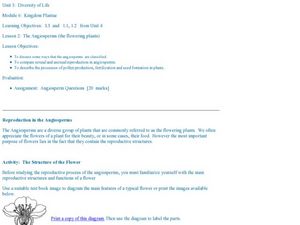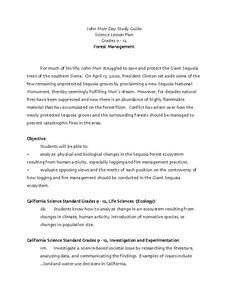Curated OER
The Ultimate Predator
Students listen to a lecture by the teacher about the "Ultimate Predator." They design a new "Ultimate Predator." Students present their creations to the class and attempt to convince their classmates that their predator is indeed the...
Curated OER
DNA Sequencing Simulation
Young scholars simulate the Sanger method of DNA sequencing using color pop-beads as a representation of nucleotides and dideoxynucleotides. Students assemble DNA sequences and run their sequences through a "sequencing gel" and sketch...
Curated OER
Using A Winogradsky Column to Analyze Microbial Communities
Students use easily obtained materials to study ecological succession in a microbiological community. This investigation is appropriate for a variety of age groups. Elementary Students be fascinated by the changes occurring over time...
Curated OER
Down, Dung and Dirty
Students investigate the stages of succession in animal dung communities. They create a dung culture using fresh cow, goat or horse dung then record data on the fungal species that appear over a two week period.
Curated OER
Plant And Animal Adaptations
Students examine plant and animal life while looking at the environments the organismisms live in. They determine how form follows function by looking an aquatic turtle and noticing its feature of adaptation features. They work in groups...
Curated OER
Environet Lesson Plans
Eleventh graders conduct Internet research about basic ecological principles and current environmental issues. They participate in a variety of outdoor experiences and develop an "Outdoor Experiences Journal" that they keep for an...
Curated OER
ARE WE IN THE MIDDLE OF A MASS EXTINCTION?
Students identify and interpret the following: What is mass extinction, and what are some theories for why it happens? How often do species become extinct? What is the normal rate of extinction? Why are some species endangered? What...
Curated OER
Invertebrates
Students identify the characteristics common to all animals. In groups, they compare the characteristics between the animals and how they are divided. To end the lesson, they compare the eight phyla of invertebrates and review the...
Curated OER
Water Quality Tests Explained
Students define all eight water quality parameters and list at list one source for each of the eight water quality parameters. They determine how each of the eight parameters affect river ecosystems.
Curated OER
Countdown Calendar
Students create a calendar of endangered species. In this preservation instructional activity, students research endangered species of plants and animals around the Lake Pontchartrain Basin. Students gather facts about the endangered...
Curated OER
How Far Away is a Tropial Rainforest?
Students explore how far a rainforest is from their home. In this rainforest lesson students examine how far they live away from the rainforest. Students use the length of their school day to compare how long it will take to travel to...
Curated OER
Bluebirds Ecology Vocabulary Exercise
In this bluebirds learning exercise, students categorize bluebird species found in their state and define vocabulary related to it. Students complete 6 vocabulary words.
Curated OER
Ecology Vocabulary
In this ecology worksheet, learners read the vocabulary words and then categorize a species found in a field, meadow, or fencerow in their state or region. Students complete 6 problems.
Curated OER
Food Chains and Webs--- "What's for dinner?"
Students study food chains and how the organisms are linked. In this investigative learning exercise students answer food chain questions, and fill out several worksheets.
Curated OER
The Angiosperms
Students study angiosperms and their classifications. In this investigative instructional activity students compare the sexual reproduction of angiosperms and seed formations.
Curated OER
Marine Protected Areas
Students design a research project about a Marine Protected Area they chose. In this marine biology instructional activity, students gather fish count and catch data then graph them. They create an information poster about their findings.
Curated OER
Arsenic and Human Health
Ninth graders concentrate on arsenic poisoning as an example of the connections among health, geography, and geology as they develop a persuasive presentation about the dangers of arsenic in the drinking water, targeting a specific...
Curated OER
Subject Selection in Clinical Trials
Students design and conduct an experiment to test a hypothesis. They create a question/objective based on the results of their experiment that can be answered by performing a human clinical trial. Students write inclusion and exclusion...
Curated OER
Earthworm Movement and Landscape Structure
Students describe differences in animal usage of habitats depending upon successional status of site. They also design other experiments to test movement patterns of animals through habitats of differing structure.
Curated OER
Introducting the Concept of Medical Ecology
Tenth graders examine the effects of the breakout of the West Nile Virus. They make predictions on its origin. They develop and present an action plan to stop the virus from spreading.
Curated OER
Field Experiments on Succession
Student develop a hypothesis regarding the effects of either mowing or fertilizer upon the diversity of plant species in a grassland ecosystem. They set up experiment field plots and measure species richness.
Curated OER
The Trial of the Bloody Sucker
Students study creatures that drink blood. In this blood suckers lessons, students watch videos to learn about creatures that drink blood. Students divide into groups and make posters about the organisms. Students then participate in a...
Curated OER
Forest Management
Learners explore the changes in the Sequoia forest ecosystem. They evaluate reasons for the changes and discuss opposing views of human activity, logging and fire management practices. Students observe a video, describe the location of...
Curated OER
Medicine: Then and Now
Students read ancient Greek texts to explore ancient healing practices and compare them to those of modern times. They explain Greek healing practices for wounds.

























